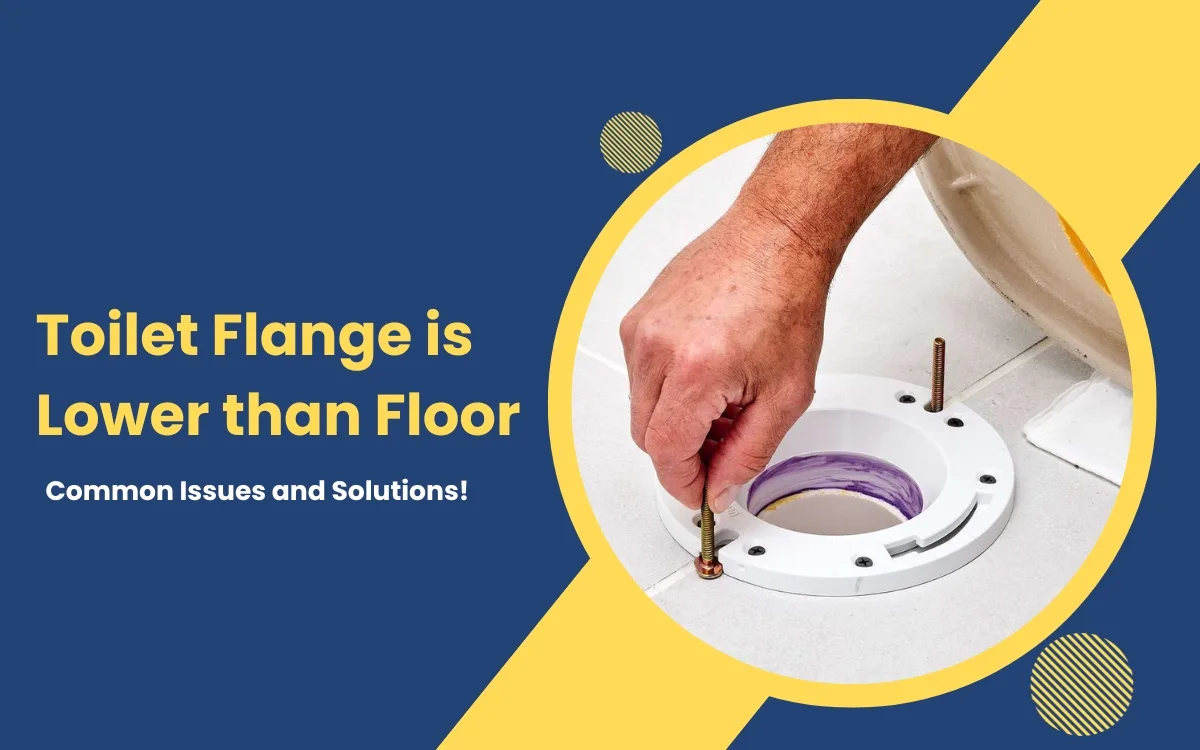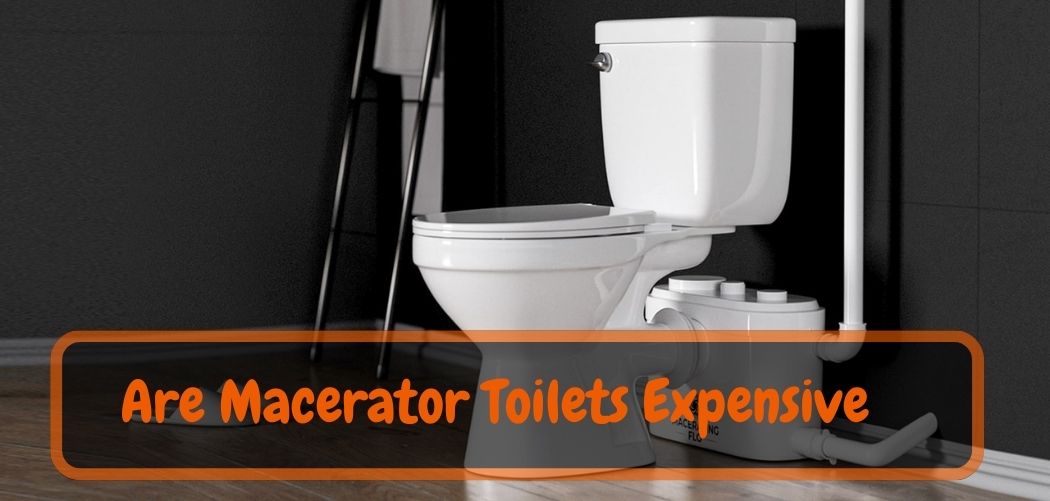The proper installation of a toilet is essential to maintain a leak-free and stable fixture in your bathroom. One crucial element of this installation process is ensuring that the toilet flange is positioned correctly in relation to the floor.
When the toilet flange is lower than the floor, it can give rise to a range of issues that may affect the toilet’s stability, sealing, and overall functionality.
In this guide, we will explore the common problems associated with a toilet flange lower than the floor and discuss the steps and solutions to address this concern, allowing you to enjoy a trouble-free toilet installation.
What if the toilet flange is lower than the floor?
If the toilet flange is lower than the floor, it can cause several issues when installing or replacing a toilet. The toilet flange should ideally be level with or slightly above the finished floor surface. Here are some potential problems and solutions if the toilet flange is lower than the floor:
01. Leaks:
- A low flange can cause leaks as the wax ring, which creates a seal between the toilet and the flange, may not be able to create a proper seal. This can lead to water leakage and potential damage to the subfloor.
Solution: You can use a thicker wax ring or a wax ring extender to help create a proper seal. Alternatively, consider raising the flange to the correct height.
02. Uneven Toilet Installation:
- Installing a toilet on a lower flange can result in an uneven toilet bowl, which may wobble or rock when you sit on it. This can be uncomfortable and potentially lead to leaks or damage.
Solution: To ensure a stable and level toilet installation, you may need to use shims or install a toilet flange spacer to raise the flange to the correct height. This will provide a stable and level base for the toilet.
03. Difficulty in Installation:
- A low flange can make it challenging to install the toilet bolts and secure the toilet to the floor properly.
Solution: You can use longer toilet bolts or flange extension kits to reach the proper height for securing the toilet to the flange securely.
04. Risk of Damage:
- If the flange is significantly lower than the floor, it may indicate that the subfloor or floor structure is damaged or deteriorated.
Solution: In cases of significant damage to the subfloor or floor structure, it is essential to repair or replace the damaged area before proceeding with the toilet installation. This may involve cutting out and replacing the damaged subfloor and ensuring that the flange is at the correct height.
please note, In some situations, it may be necessary to call a professional plumber or a handyman to assess the condition of the flange and the floor and make the necessary repairs or adjustments. Proper installation of the toilet is crucial to prevent leaks, maintain stability, and ensure the longevity of the toilet fixture.
Toilet Flange Lower Floor Measurement
Here’s a simple table about “Toilet Flange Lower Floor Measurement” to provide a visual reference:
| Aspect | Description |
| Location of Toilet Flange | On the bathroom floor |
| Measurement Method | Measure from the floor to the top edge of the flange |
| Ideal Height | Slightly above the finished floor surface (usually 1/4 to 1/2 inch above) |
| Adjustment if Necessary | Use flange extender or spacer if too high; address subfloor or use a thicker wax ring if too low |
| Securing the Flange | Ensure it is securely fastened to the floor for stability |
This table provides a summary of key aspects related to measuring and adjusting the toilet flange's height in relation to the lower floor for a proper toilet installation.
How to Fix a Flange That’s Too Lower?
Fixing a toilet flange that is too low involves raising it to the correct height to ensure a proper and secure toilet installation. Here are the steps to fix a low toilet flange:
Tools and Materials Needed:
- Toilet flange extender kit or toilet flange spacer
- Wax ring
- Toilet bolts and nuts
- Screwdriver or wrench
- Hacksaw or reciprocating saw (if needed)
- PVC cement (if using a PVC flange)
Steps:
- Turn off the water supply: Shut off the water supply to the toilet by turning the shutoff valve clockwise. Flush the toilet to empty the tank and the bowl.
- Remove the toilet: Unscrew the nuts securing the toilet bolts to the flange and lift the toilet off the flange. Set the toilet aside.
- Inspect the flange: Examine the existing flange to determine if it’s damaged or if it’s a metal or PVC flange. If it’s damaged or in poor condition, you may need to replace it entirely.
- Install the flange extender or spacer:
- If you’re using a flange extender kit: Place the extender on top of the existing flange, aligning the bolt holes.
- If you’re using a flange spacer: Insert the spacer into the existing flange, making sure it fits securely.
- Secure the extender or spacer: Use screws or bolts (provided with the kit) to secure the extender or spacer to the existing flange. Make sure it is firmly in place.
- Cut the toilet bolts (if needed): If the existing toilet bolts are too long for the new flange height, you may need to trim them using a hacksaw or reciprocating saw to the appropriate length.
- Install the wax ring: Place a new wax ring onto the flange extender or spacer. The wax ring should be positioned with the tapered side facing up, and the toilet bolts should pass through the wax ring.
- Lower the toilet: Carefully lower the toilet bowl onto the wax ring, ensuring that the toilet bolts pass through the mounting holes in the base of the toilet. Apply gentle downward pressure to compress the wax ring.
- Secure the toilet: Place washers and nuts onto the toilet bolts and tighten them evenly using a wrench or screwdriver. Be careful not to overtighten, as this can crack the toilet.
- Reconnect the water supply: Turn the water supply valve counterclockwise to restore the water flow to the toilet tank. Allow the tank to fill.
- Test for leaks: Flush the toilet and check for any leaks around the base of the toilet. If you notice any leaks, tighten the nuts on the toilet bolts slightly.
- Check for stability: Ensure that the toilet is level and stable. If it wobbles, you may need to use shims to stabilize it.
- Reattach the toilet seat and lid: If you removed the toilet seat and lid, reattach them securely.
By following these steps, you can fix a low toilet flange by raising it to the correct height, ensuring a proper and leak-free toilet installation. If you are not comfortable with this DIY task, it's always a good idea to consult a professional plumber for assistance.
What happens if toilet flange is too low?
If the toilet flange is too low, it can lead to various problems during the installation and use of the toilet. The flange serves as the base for securing the toilet to the floor and creating a watertight seal. When it is positioned lower than the floor level, several issues may arise.
Firstly, it can result in an improper seal between the toilet and the flange, leading to water leaks and potential damage to the subfloor. Additionally, the toilet may sit unevenly or wobble, causing discomfort and potential damage.
Installing a toilet on a low flange can also be challenging, as it may require longer bolts or shims to secure the toilet properly. In some cases, a low flange may indicate underlying structural problems with the floor or subfloor, which may need addressing.
Therefore, it’s essential to raise the flange to the correct height for a secure, stable, and leak-free toilet installation.
What if toilet flange is not level with floor?
If the toilet flange is not level with the floor, it can lead to several issues when installing or replacing a toilet. The toilet flange should ideally be at the same level as the finished floor surface or slightly above it for a proper and secure installation.
When it is not level with the floor, several problems can occur. Firstly, it can result in an uneven toilet installation, causing the toilet to wobble or rock, which can be uncomfortable and potentially lead to leaks or damage over time. Secondly, it may make it challenging to create a proper seal between the toilet and the flange, increasing the risk of water leakage. To address this issue, you may need to use shims or a toilet flange spacer to raise the toilet to the correct level.
In more severe cases, it might be necessary to repair or replace the subfloor or floor structure to ensure the flange is level with the floor, providing a stable and secure base for the toilet. Proper alignment of the flange with the floor is crucial for a successful and trouble-free toilet installation.
Should toilet flange be higher than floor?
Ideally, a toilet flange should be level with or slightly above the finished floor surface when installing or replacing a toilet. Having the flange at the correct height is crucial for a proper and secure toilet installation.
If the flange is too low, it can lead to several issues, including an uneven toilet installation that may cause wobbling, rocking, and instability. Additionally, a low flange can make it challenging to create a proper seal between the toilet and the flange, increasing the risk of water leakage and potential damage to the subfloor.
Therefore, it’s recommended to ensure that the toilet flange is level with or slightly above the floor to facilitate a stable, leak-free, and long-lasting toilet installation. If the flange is too low, it should be raised using appropriate methods and materials to achieve the correct height.
How do you raise the height of a toilet flange?
Raising the height of a toilet flange is necessary when it is too low in relation to the finished floor surface. Here are the steps to raise the height of a toilet flange:
- Turn off the water supply: Shut off the water supply to the toilet by turning the shutoff valve clockwise. Flush the toilet to empty the tank and the bowl.
- Remove the toilet: Unscrew the nuts securing the toilet bolts to the flange and lift the toilet off the flange. Set the toilet aside.
- Inspect the flange: Examine the existing flange to determine its material (usually PVC or metal) and condition. If it’s damaged or in poor condition, consider replacing it.
- Install a flange extender or spacer: Use a flange extender kit or a flange spacer specifically designed for this purpose. Place the extender on top of the existing flange, aligning the bolt holes or insert the spacer into the existing flange.
- Secure the extender or spacer: Use screws or bolts provided with the kit to secure the extender or spacer to the existing flange. Ensure that it is firmly in place.
- Cut the toilet bolts (if needed): If the existing toilet bolts are too long for the new flange height, trim them using a hacksaw or reciprocating saw to the appropriate length.
- Install the wax ring: Place a new wax ring onto the flange extender or spacer. The wax ring should be positioned with the tapered side facing up, and the toilet bolts should pass through the wax ring.
- Lower the toilet: Carefully lower the toilet bowl onto the wax ring, ensuring that the toilet bolts pass through the mounting holes in the base of the toilet. Apply gentle downward pressure to compress the wax ring.
- Secure the toilet: Place washers and nuts onto the toilet bolts and tighten them evenly using a wrench or screwdriver. Be careful not to overtighten, as this can crack the toilet.
- Reconnect the water supply: Turn the water supply valve counterclockwise to restore the water flow to the toilet tank. Allow the tank to fill.
- Test for leaks: Flush the toilet and check for any leaks around the base of the toilet. If you notice any leaks, tighten the nuts on the toilet bolts slightly.
- Check for stability: Ensure that the toilet is level and stable. If it wobbles, you may need to use shims to stabilize it.
By following these steps, you can raise the height of a toilet flange to the correct level, ensuring a proper and leak-free toilet installation. If you are not comfortable with this DIY task, it's always a good idea to consult a professional plumber for assistance.
Frequently Asked Questions (FAQ) about Toilet Flange Replacement When It’s Lower Than the Floor:
If your toilet flange is lower than the floor, you may need to replace it or use a flange extender to raise it to the correct height for a proper toilet installation.
Yes, a toilet flange extender can be used to raise the flange height by 1 inch or more to align it with the floor level.
Yes, a flange that is 1/2 inch below the floor can cause issues with toilet stability and sealing. It’s recommended to raise it to the floor level for a secure installation.
The toilet flange should ideally be flush with the finished floor surface or slightly above it to ensure a proper seal and stable toilet installation.
Turn off the water supply and remove the toilet.
1. Examine the flange and decide if it needs replacing or if you can use an extender.
2. Install a flange extender or spacer to raise the flange to the correct height.
3. Secure the extender, install a new wax ring, and reattach the toilet.
4. Test for leaks and ensure the toilet is stable.
If you are comfortable with basic plumbing tasks, you can attempt to replace a low toilet flange yourself. However, if you’re unsure or encounter difficulties, it’s advisable to consult a professional plumber to avoid any potential issues.
Closing Remainder:
Ensuring that your toilet flange is properly aligned with your bathroom floor is a critical aspect of maintaining a functional and leak-free toilet. When the flange is lower than the floor, it can lead to various challenges and potential problems.
However, by addressing these issues through methods such as flange extenders or spacers, you can achieve a secure and level installation. Remember that if you ever feel unsure about these procedures or encounter complex problems, consulting a professional plumber is a wise choice to ensure your toilet operates optimally and without any issues in the future.
A well-installed toilet flange not only enhances your bathroom’s functionality but also contributes to a comfortable and efficient bathroom experience.










